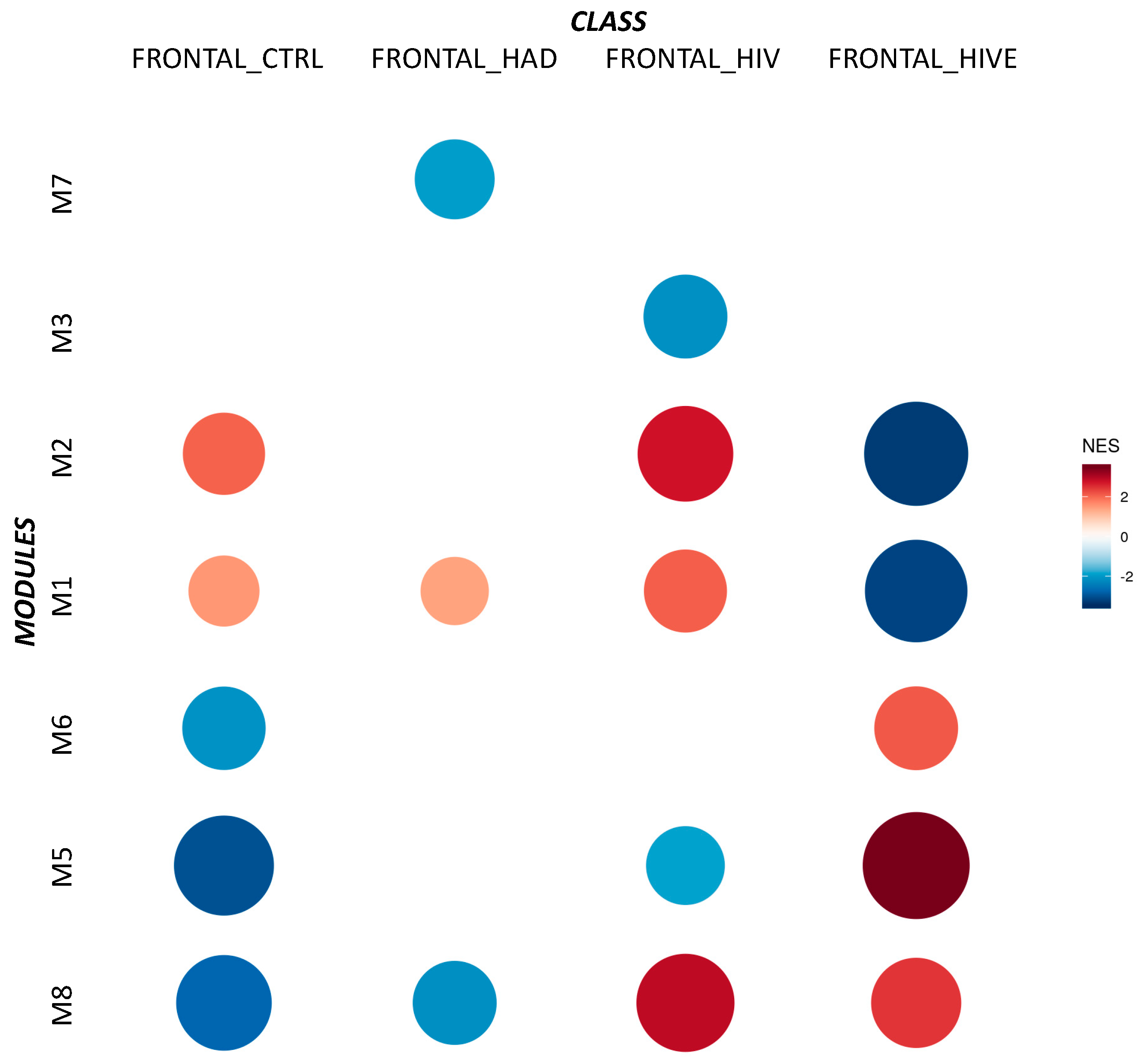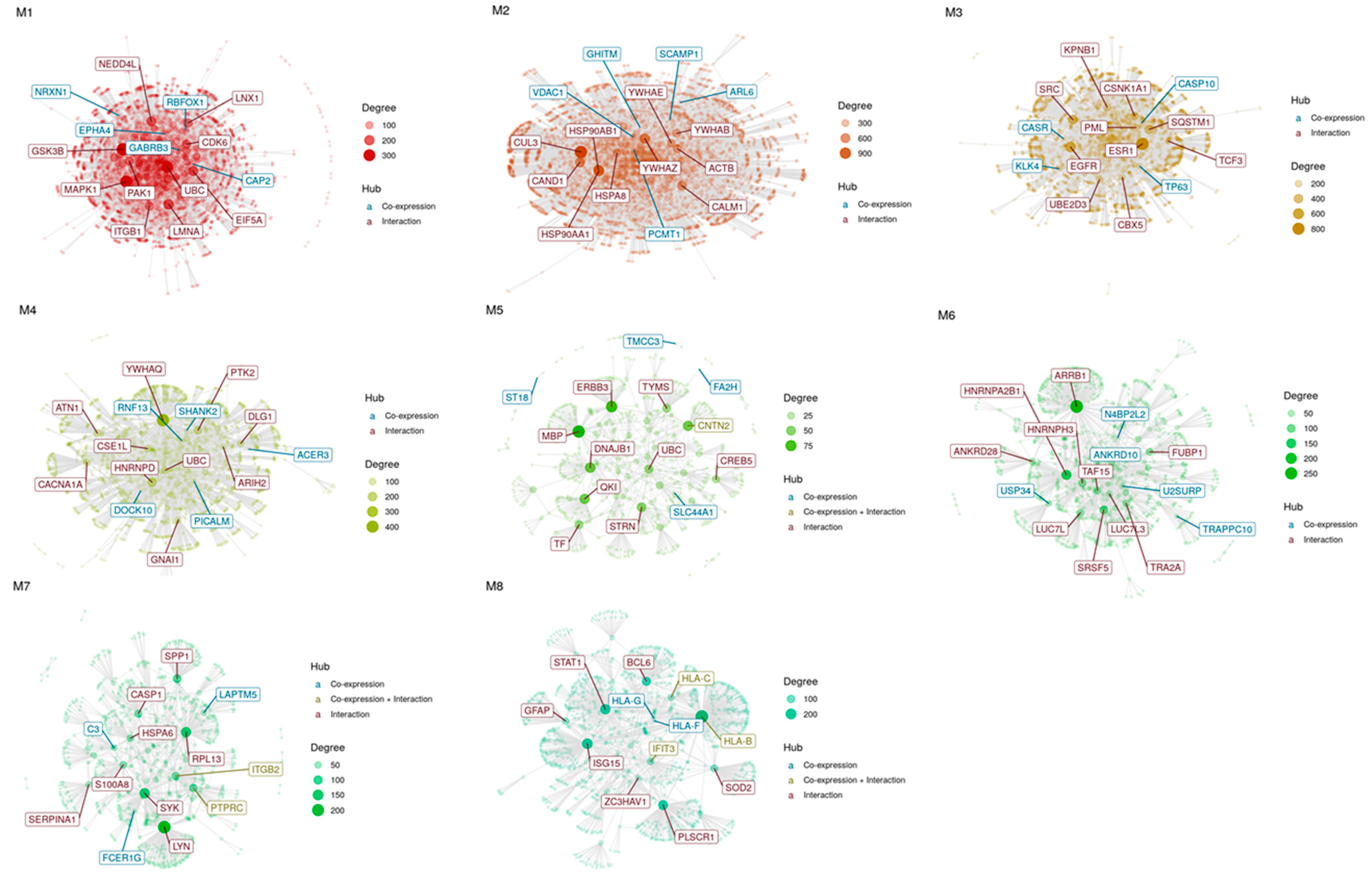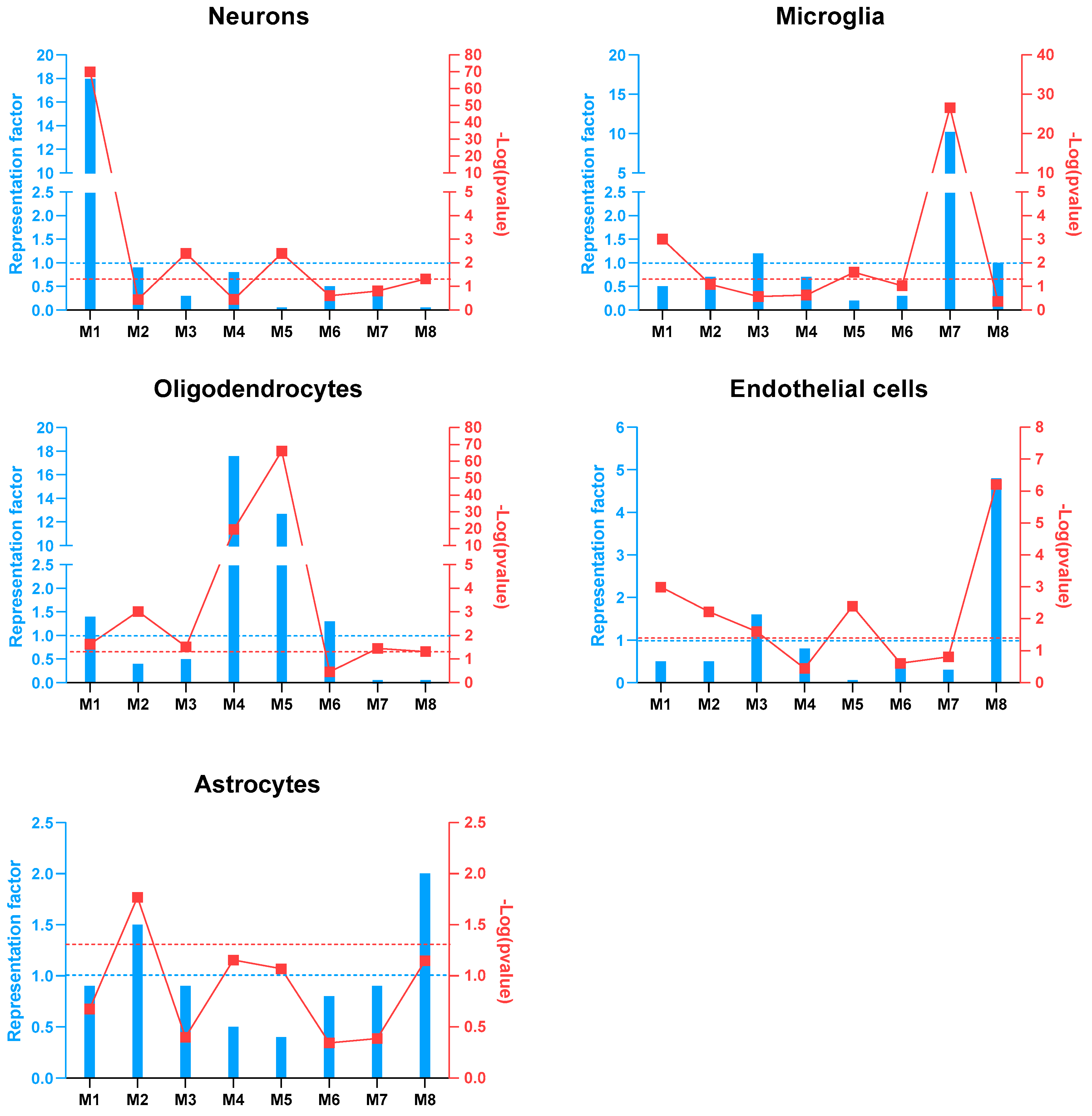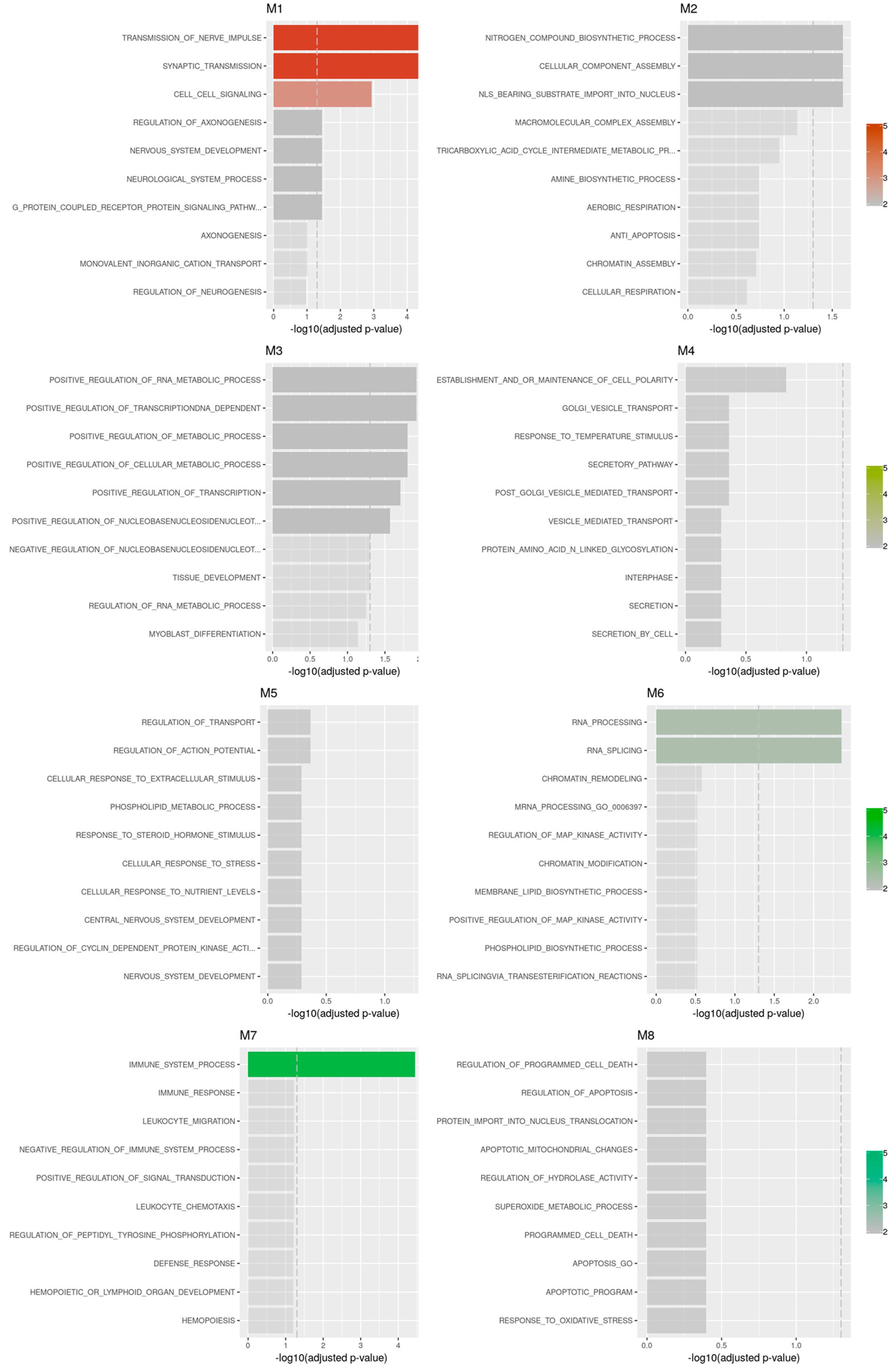Gene Co-Expression Network Modular Analysis Reveals Altered Immune Mechanisms in HIV-HAND
Abstract
1. Introduction
2. Materials and Methods
2.1. Dataset Selection
2.2. Co-Expression Modular Network Analysis
2.3. Evaluation of the Involvement of Different Brain Cell Types in the Different Co-Expression Modules
2.4. Pathway Analysis
2.5. Gene Module Regulation
3. Results
3.1. Gene Co-Expression Network Modular Analysis
3.2. Gene Co-Expression Network Modular Analysis of HIV-HAND
4. Discussion
Author Contributions
Funding
Data Availability Statement
Conflicts of Interest
References
- Heaton, R.K.; Clifford, D.B.; Franklin, D.R.; Woods, S.P.; Ake, C.; Vaida, F.; Ellis, R.J.; Letendre, S.L.; Marcotte, T.D.; Atkinson, J.H.; et al. HIV-associated neurocognitive disorders persist in the era of potent antiretroviral therapy: Charter Study. Neurology 2010, 75, 2087–2096. [Google Scholar] [CrossRef] [PubMed]
- Morgello, S.; Mahboob, R.; Yakoushina, T.; Khan, S.; Hague, K. Autopsy Findings in a Human Immunodeficiency Virus–Infected Population Over 2 Decades. Arch. Pathol. Lab. Med. 2002, 126, 182–190. [Google Scholar] [CrossRef]
- Levine, A.J.; Miller, J.A.; Shapshak, P.; Gelman, B.; Singer, E.J.; Hinkin, C.H.; Commins, D.; Morgello, S.; Grant, I.; Horvath, S. Systems analysis of human brain gene expression: Mechanisms for HIV-associated neurocognitive impairment and common pathways with Alzheimer’s disease. BMC Med. Genom. 2013, 6, 1–20. [Google Scholar] [CrossRef]
- Gelman, B.B.; Lisinicchia, J.G.; Morgello, S.; Masliah, E.; Commins, D.; Achim, C.L.; Fox, H.S.; Kolson, D.L.; Grant, I.; Singer, E.; et al. Neurovirological Correlation with HIV-Associated Neurocognitive Disorders and Encephalitis in a HAART-Era Cohort. JAIDS J. Acquir. Immune Defic. Syndr. 2013, 62, 487–495. [Google Scholar] [CrossRef] [PubMed]
- Gelman, B.B.; Chen, T.; Lisinicchia, J.G.; Soukup, V.M.; Carmical, J.R.; Starkey, J.M.; Masliah, E.; Commins, D.L.; Brandt, D.; Grant, I.; et al. The National NeuroAIDS Tissue Consortium Brain Gene Array: Two Types of HIV-Associated Neurocognitive Impairment. PLoS ONE 2012, 7, e46178. [Google Scholar] [CrossRef] [PubMed]
- Russo, P.S.T.; Ferreira, G.R.; Cardozo, L.E.; Bürger, M.C.; Arias-Carrasco, R.; Maruyama, S.R.; Hirata, T.D.C.; Lima, D.S.; Passos, F.M.; Fukutani, K.F.; et al. CEMiTool: A Bioconductor package for performing comprehensive modular co-expression analyses. BMC Bioinform. 2018, 19, 1–13. [Google Scholar] [CrossRef]
- Zuberi, K.; Franz, M.; Rodriguez, H.; Montojo, J.; Lopes, C.T.; Bader, G.D.; Morris, Q. GeneMANIA Prediction Server 2013 Update. Nucleic Acids Res. 2013, 41, W115–W122. [Google Scholar] [CrossRef] [PubMed]
- Liberzon, A.; Birger, C.; Thorvaldsdóttir, H.; Ghandi, M.; Mesirov, J.P.; Tamayo, P. The Molecular Signatures Database Hallmark Gene Set Collection. Cell Syst. 2015, 1, 417–425. [Google Scholar] [CrossRef] [PubMed]
- McKenzie, A.T.; Wang, M.; Hauberg, M.E.; Fullard, J.F.; Kozlenkov, A.; Keenan, A.; Hurd, Y.L.; Dracheva, S.; Casaccia, P.; Roussos, P.; et al. Brain Cell Type Specific Gene Expression and Co-expression Network Architectures. Sci. Rep. 2018, 8, 8868. [Google Scholar] [CrossRef] [PubMed]
- Subramanian, A.; Tamayo, P.; Mootha, V.K.; Mukherjee, S.; Ebert, B.L.; Gillette, M.A.; Paulovich, A.; Pomeroy, S.L.; Golub, T.R.; Lander, E.S.; et al. Gene set enrichment analysis: A knowledge-based approach for interpreting genome-wide expression profiles. Proc. Natl. Acad. Sci. USA 2005, 102, 15545–15550. [Google Scholar] [CrossRef] [PubMed]
- Khatri, P.; Sirota, M.; Butte, A.J. Ten years of pathway analysis: Current approaches and outstanding challenges. PLoS Comput. Biol. 2012, 8, e1002375. [Google Scholar] [CrossRef] [PubMed]
- Wang, J.; Vasaikar, S.; Shi, Z.; Greer, M.; Zhang, B. WebGestalt 2017: A more comprehensive, powerful, flexible and interactive gene set enrichment analysis toolkit. Nucleic Acids Res. 2017, 45, W130–W137. [Google Scholar] [CrossRef] [PubMed]
- Kanehisa, M.; Furumichi, M.; Tanabe, M.; Sato, Y.; Morishima, K. KEGG: New perspectives on genomes, pathways, diseases and drugs. Nucleic Acids Res. 2017, 45, D353–D361. [Google Scholar] [CrossRef]
- Kuleshov, M.V.; Jones, M.R.; Rouillard, A.D.; Fernandez, N.F.; Duan, Q.; Wang, Z.; Koplev, S.; Jenkins, S.L.; Jagodnik, K.M.; Lachmann, A.; et al. Enrichr: A comprehensive gene set enrichment analysis web server 2016 update. Nucleic Acids Res. 2016, 44, W90–W97. [Google Scholar] [CrossRef] [PubMed]
- Tozzi, V.; Balestra, P.; Serraino, D.; Bellagamba, R.; Corpolongo, A.; Piselli, P.; Lorenzini, P.; Visco-Comandini, U.; Vlassi, C.; Quartuccio, M.E.; et al. Neurocognitive impairment and survival in a cohort of HIV-infected patients treated with HAART. AIDS Res. Hum. Retrovir. 2005, 21, 706–713. [Google Scholar] [CrossRef] [PubMed]
- McPhail, M.E.; Robertson, K.R. Neurocognitive impact of antiretroviral treatment: Thinking long-term. Curr. HIV/AIDS Rep. 2011, 8, 249–256. [Google Scholar] [CrossRef] [PubMed]
- Ellis, R.; Langford, D.; Masliah, E. HIV and antiretroviral therapy in the brain: Neuronal injury and repair. Nat. Rev. Neurosci. 2007, 8, 33–44. [Google Scholar] [CrossRef]
- Kraft-Terry, S.D.; Buch, S.J.; Fox, H.S.; Gendelman, H.E. A Coat of Many Colors: Neuroimmune Crosstalk in Human Immunodeficiency Virus Infection. Neuron 2009, 64, 133–145. [Google Scholar] [CrossRef]
- Levine, A.J.; Soontornniyomkij, V.; Achim, C.L.; Masliah, E.; Gelman, B.B.; Sinsheimer, J.S.; Singer, E.J.; Moore, D.J. Multilevel analysis of neuropathogenesis of neurocognitive impairment in HIV. J. Neurovirol. 2016, 22, 431–441. [Google Scholar] [CrossRef]
- Sanna, P.P.; Repunte-Canonigo, V.; Masliah, E.; Lefebvre, C. Gene expression patterns associated with neurological disease in human HIV infection. PLoS ONE 2017, 12, e0175316. [Google Scholar] [CrossRef]
- Shapshak, P.; Duncan, R.; Minagar, A.; Rodriguez De La Vega, P.; Stewart, R.V.; Goodkin, K. Elevated expression of IFN-gamma in the HIV-1 infected brain. Front. Biosci. 2004, 9, 1073–1081. [Google Scholar] [CrossRef] [PubMed]
- Campbell, I.L.; Krucker, T.; Steffensen, S.; Akwa, Y.; Powell, H.C.; Lane, T.; Carr, D.J.; Gold, L.H.; Henriksen, S.J.; Siggins, G.R. Structural and functional neuropathology in transgenic mice with CNS expression of IFN-α. Proc. Brain Res. 1999, 835, 46–61. [Google Scholar] [CrossRef]
- Blank, T.; Detje, C.N.; Spieß, A.; Hagemeyer, N.; Brendecke, S.M.; Wolfart, J.; Staszewski, O.; Zöller, T.; Papageorgiou, I.; Schneider, J.; et al. Brain Endothelial- and Epithelial-Specific Interferon Receptor Chain 1 Drives Virus-Induced Sickness Behavior and Cognitive Impairment. Immunity 2016, 44, 901–912. [Google Scholar] [CrossRef]
- Johansson, A.; Larsson, A.; Nygren, I.; Blennow, K.; Askmark, H. Increased serum and cerebrospinal fluid FGF-2 levels in amyotrophic lateral sclerosis. Neuroreport 2003, 14, 1867–1869. [Google Scholar] [CrossRef]
- Mashayekhi, F.; Hadavi, M.; Vaziri, H.R.; Naji, M. Increased acidic fibroblast growth factor concentrations in the serum and cerebrospinal fluid of patients with Alzheimer’s disease. J. Clin. Neurosci. 2010, 17, 357–359. [Google Scholar] [CrossRef]
- Bharti, A.R.; Woods, S.P.; Ellis, R.J.; Cherner, M.; Rosario, D.; Potter, M.; Heaton, R.K.; Everall, I.P.; Masliah, E.; Grant, I.; et al. Fibroblast growth factors 1 and 2 in cerebrospinal fluid are associated with HIV disease, methamphetamine use, and neurocognitive functioning. HIV/AIDS—Res. Palliat. Care 2016, 8, 93–99. [Google Scholar] [CrossRef] [PubMed][Green Version]
- Kao, S.; Miyagi, E.; Mallorson, R.; Saito, H.; Sukegawa, S.; Mukherji, A.; Mateja, A.; Ferhadian, D.; Fabryova, H.; Clouse, K.; et al. The Myeloid-Specific Transcription Factor PU.1 Upregulates Mannose Receptor Expression but Represses Basal Activity of the HIV-LTR Promoter. J. Virol. 2022, 96, e00652-22. [Google Scholar] [CrossRef]
- Corley, M.J.; Dye, C.; D’Antoni, M.L.; Byron, M.M.; Yo, K.L.A.; Lum-Jones, A.; Nakamoto, B.; Valcour, V.; Sahbandar, I.; Shikuma, C.M.; et al. Comparative DNA Methylation Profiling Reveals an Immunoepigenetic Signature of HIV-related Cognitive Impairment. Sci. Rep. 2016, 6, 1–13. [Google Scholar] [CrossRef]
- Sethi, B.; Kumar, V.; Mahato, K.; Coulter, D.W.; Mahato, R.I. Recent advances in drug delivery and targeting to the brain. J. Control. Release 2022, 350, 668–687. [Google Scholar] [CrossRef]







| Patients | Global Impairment Score | White Matter HIV-1 RNA (log10 copies/g) | Neostriatum HIV-1 RNA (log10 copies/g) | Frontal Cortex HIV-1 RNA (log10 copies/g) | Age at Death (Years ± SD) | Sex |
|---|---|---|---|---|---|---|
| CTRL | 0 | 0 | 0 | 50.0 ± 10.4 | Male = 5; Female = 1 | |
| HIV | 4.0 ± 1.4 | 3.53 ± 0.69 | 3.84 ± 0.50 | 3.65 ± 0.74 | 49.5 ± 8.4 | Male = 6; Female = 0 |
| HAND | 6.9 ± 1.1 | 3.85 ± 2.54 | 3.51 ± 1.37 | 3.63 ± 1.12 | 43.7 ± 9.8 | Male = 7; Female = 0 |
| HIVE | 7.5 ± 2.2 | 7.40 ± 1.80 | 7.27 ± 0.84 | 6.16 ± 1.34 | 42.8 ± 8.9 | Male = 5; Female = 0 |
| Pathway | FRONTAL_CTRL: Adjusted p-Value | FRONTAL_CTRL: NES | FRONTAL_HAND: Adjusted p-Value | FRONTAL_HAND: NES | FRONTAL_HIV: Adjusted p-Value | FRONTAL_HIV: NES | FRONTAL:HIVE: Adjusted p-Value | FRONTAL:HIVE: NES |
|---|---|---|---|---|---|---|---|---|
| M1 | 0.00043 | 1.53 | 0.0025 | 1.41 | 0.00144 | 2.08 | 0.00036 | −3.18 |
| M2 | 0.00043 | 2.04 | 1 | −0.52 | 0.00119 | 2.77 | 0.00036 | −3.27 |
| M3 | 0.99909 | −0.63 | 0.50783 | 1.09 | 0.00066 | −2.13 | 0.48958 | 1.06 |
| M4 | 0.05481 | −1.33 | 1 | −0.58 | 0.06453 | 1.27 | 0.93217 | 0.78 |
| M5 | 0.00043 | −3.02 | 1 | −0.57 | 0.00066 | −1.88 | 0.00036 | 3.46 |
| M6 | 0.00043 | −2.1 | 0.50783 | 1.1 | 0.19262 | −1.19 | 0.00036 | 2.12 |
| M7 | 0.24902 | 1.17 | 0.00082 | −1.93 | 0.1325 | 1.26 | 0.75452 | −0.88 |
| M8 | 0.00043 | −2.76 | 0.00082 | −2.13 | 0.00082 | 2.91 | 0.00036 | 2.46 |
Publisher’s Note: MDPI stays neutral with regard to jurisdictional claims in published maps and institutional affiliations. |
© 2022 by the authors. Licensee MDPI, Basel, Switzerland. This article is an open access article distributed under the terms and conditions of the Creative Commons Attribution (CC BY) license (https://creativecommons.org/licenses/by/4.0/).
Share and Cite
Petralia, M.C.; Nicoletti, F.; Tancheva, L.; Kalfin, R.; Fagone, P.; Mangano, K. Gene Co-Expression Network Modular Analysis Reveals Altered Immune Mechanisms in HIV-HAND. Brain Sci. 2022, 12, 1378. https://doi.org/10.3390/brainsci12101378
Petralia MC, Nicoletti F, Tancheva L, Kalfin R, Fagone P, Mangano K. Gene Co-Expression Network Modular Analysis Reveals Altered Immune Mechanisms in HIV-HAND. Brain Sciences. 2022; 12(10):1378. https://doi.org/10.3390/brainsci12101378
Chicago/Turabian StylePetralia, Maria Cristina, Ferdinando Nicoletti, Lyubka Tancheva, Reni Kalfin, Paolo Fagone, and Katia Mangano. 2022. "Gene Co-Expression Network Modular Analysis Reveals Altered Immune Mechanisms in HIV-HAND" Brain Sciences 12, no. 10: 1378. https://doi.org/10.3390/brainsci12101378
APA StylePetralia, M. C., Nicoletti, F., Tancheva, L., Kalfin, R., Fagone, P., & Mangano, K. (2022). Gene Co-Expression Network Modular Analysis Reveals Altered Immune Mechanisms in HIV-HAND. Brain Sciences, 12(10), 1378. https://doi.org/10.3390/brainsci12101378








